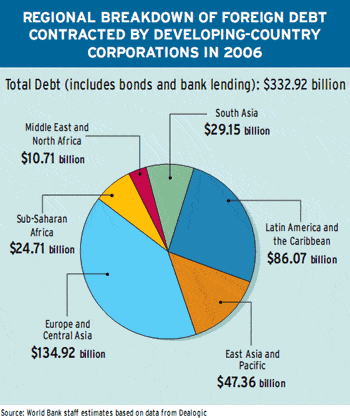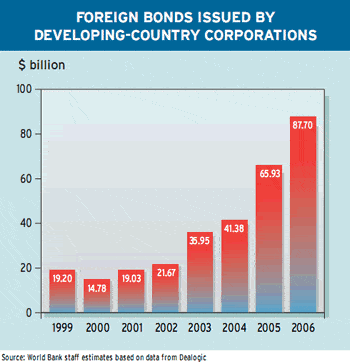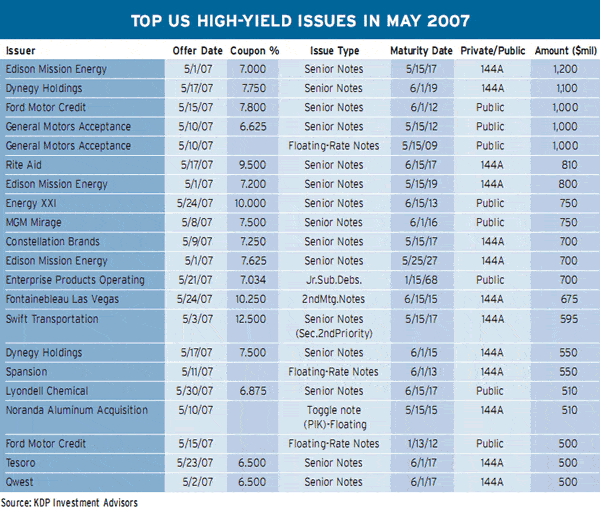Corporate financing news / corporate debt
Corporations based in emerging market countries have increased their global borrowing substantially in recent years, putting themselves at risk to a sudden shift in investor sentiment and a turn in the global credit cycle, according to an analysis by the World Bank.
Private and state-owned corporations in developing countries raised an unprecedented $333 billion through syndicated bank loans and international bond issuance in 2006, up sharply from $88 billion in 2002, according to World Bank staff estimates based on data from Dealogic. The rapid growth in external debt contracted by these companies over the past four years may represent a trend whose potential implications are not yet well understood, the World Bank says in its annual report, Global Development Finance 2007, released in late May.
“Companies and banks in emerging markets are taking advantage of favorable conditions as well as much more liberal financial regulations to come to the markets in quite a massive way,” says Mansoor Dailami, manager of international finance in the World Bank’s Development Prospects Group and lead author of the report. “Access to global capital markets allows these corporations to diversify their sources of funds, improve risk management through more sophisticated financing instruments, borrow at longer maturities, and reduce their cost of capital,” Dailami says. As emerging market corporations have increased in size and expanded their international operations, however, they have increased their exposure to interest-rate and currency risks, the report says.
Despite advances in risk management by many firms, concerns remain in two particular areas that are reminiscent of the position of emerging market corporations immediately before the East Asian financial crisis of 1997-1998, the report says. First, growing Japanese yen-denominated liabilities held by some corporations may not be adequately hedged against currency movements or a sudden unwinding of the yen carry trade. “Because even a modest appreciation of the yen could significantly weaken corporate balance sheets, debt-equity ratios and the cost of debt financing may be significantly underestimated unless foreign exchange risks have been hedged,” the World Bank report says.
Second, market participants have raised concerns over weak credit-risk management in emerging market corporations, the report continues. Because derivatives markets are not well developed in some of these countries, it is difficult for these companies to develop an enterprise-wide risk-management framework and to measure, aggregate and hedge risk. Moreover, credit risk may be substantially underestimated during the current peak of the credit cycle.
 Currency Exposure
Currency Exposure
Meanwhile banks’ exposure to foreign-currency borrowing should be given special attention, the report says. “Several countries, particularly in the transition economies of Europe and Central Asia, are now experiencing a credit boom, spearheaded by banks of untested financial health and stamina,” the report says. “Concerns are growing that some of these banks—particularly in Estonia, Hungary, Kazakhstan, Latvia, Lithuania, Russia and Ukraine—are increasing their foreign exchange exposure to levels that have the potential to jeopardize financial stability,” it says.
Market-determined exchange rates, far greater corporate transparency and government regulation of foreign borrowing by banks are needed to reduce the likelihood of excessive corporate foreign borrowing and financial distress, the World Bank report says. It warns that boom-and-bust cycles can have dire consequences and that excessive corporate borrowing could limit the host government’s capacity to issue sovereign debt on international markets.
Corporate debt issues have grown bigger, which has brought greater liquidity to secondary markets and stimulated the development of a market for credit default swaps on emerging corporate debt, the report says. These swaps are marketed to global investors, particularly hedge funds and insurance companies that want to increase their exposure in emerging markets without having to invest directly in the underlying assets.
Are Spreads Realistic?
Meanwhile, the spread of corporate bond issues from emerging market borrowers over those of comparable US treasury securities has narrowed from about 452 basis points in 1999 to about 349 basis points in 2006. “With global financial markets operating in recent years with unprecedented liquidity, heightened risk appetite among investors, and a spectrum of new players and actors, the possibility of corporate credit spreads underestimating their long-term equilibrium levels is a real one,” the World Bank report says.
Growth in the global economy is moderating, and financial markets are signaling a turn in the financing conditions facing the developing world, the bank says. While most developing countries have clearly improved their ability to deal with the moderate shocks that may accompany changes in the international credit environment, and while a smooth adjustment is most likely, turning points are risky in nature, it says.
Global gross domestic product expanded 4% in 2006, which probably represents a cyclical peak, with growth expected to slow to about 3.5% in 2009, the World Bank says. The expansion of developing economies is projected to moderate gradually from 7.3% in 2006 to about 6% in 2009, due to rising interest rates and developing capacity constraints.
 Coherent Approach
Coherent Approach
As capital markets have integrated rapidly over the past few years and as developing-country corporations have been raising funds overseas, the need for a more coherent global approach to regulating cross-border public offerings and listings of securities has become more urgent, the report says. It calls for regulators and governments to pay more attention to the transparency and quality of accounting standards.
Equity flows accounted for almost three-quarters of capital flows to developing countries last year. Net private capital flows to emerging market countries rose 17% to a record $647 billion in 2006, but the rate of growth in these flows slowed from 34% in 2005. “What we’re seeing now is a leveling off of these increasing capital flows,” Dailami says. The projected slowdown in global growth, driven in part by a downturn in the United States and reinforced by tighter monetary policy in high-income countries, could make financing conditions for developing countries somewhat less favorable in coming years, he says.
“Due to high levels of liquidity and the chasing of yield, we are seeing a lack of differentiation in the pricing of various financial assets in global markets today,” says William Rhodes, president and CEO of Citibank and senior vice chairman of Citi. Speaking at the spring membership meeting in Athens of the Washington, DC-based Institute of International Finance, of which he is senior vice chairman, Rhodes said, “The time has assuredly come when investors need to differentiate much more carefully between various types of risks, and to price risks according to fundamentals.”
Rhodes added, “At the same time, given the market vulnerabilities that now exist, the governments of a rising number of emerging market economies need to maintain sound economic policies and pursue needed structural reforms—in some cases these have been postponed for much too long.”
 High-Yield Issuance Rises
High-Yield Issuance Rises
Kingman Penniman, president and chief executive of high-yield bond research firm KDP Investment Advisors, based in Montpelier, Vermont, says, “Ultimately, we do expect to see a general repricing of risk.” Spreads of high-yield issuers to treasury bonds are still close to historical lows, and issuance remains robust, he says.
New high-yield bond issues in the US market totaled $23.5 billion in May, second only to the $27.2 billion monthly record set in November 2006. “This pales in comparison to the $180 billion in leveraged loans that are expected to come to market in the next month or two,” Penniman says. Most of these loans are related to leveraged buyouts of corporations. “There seems to be a sense in the market that now is the time to get your deals done before liquidity dries up,” he says. “So far, the appetite is still there to meet the demand.”
The yield on the 10-year US treasury bond rose to 5.31% on June 12, the highest level in more than five years. “There were no specific data accounting for the rise in bond yields,” according to Penniman. “It was the culmination of a lot of things, including a realization that the US economy is going to be stronger than some thought. A number of economists threw in the towel on predicting a US rate cut, and members of the Fed remain pretty hawkish in their testimony,” he says.
Meanwhile, the Treasury’s 10-year bond auction in June attracted indirect bids, which are a proxy of foreign central bank buying, of just 10.9% of the total, down from 44.3% at the previous 10-year auction in May. This raised concern that central banks of Asia and Middle Eastern oil-producing countries are finding other investments for their rising foreign exchange reserves.

Gordon Platt



